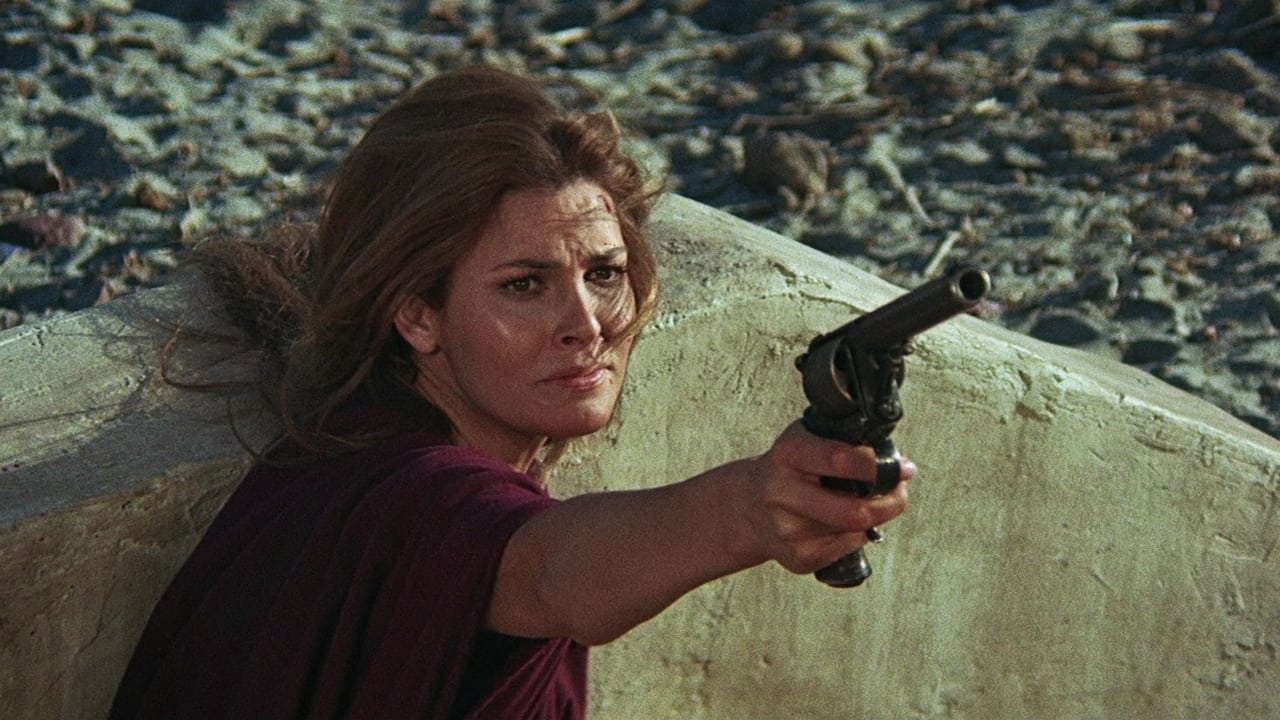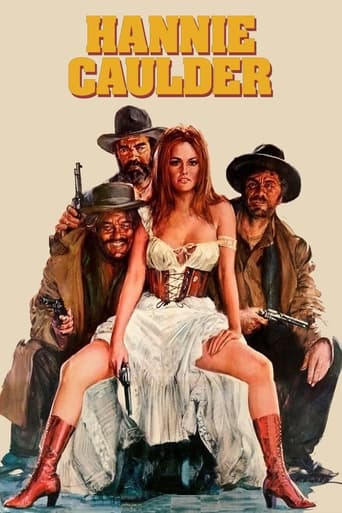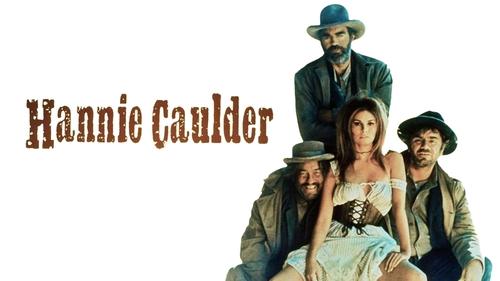



Very disappointed :(
Admirable film.
I gave this film a 9 out of 10, because it was exactly what I expected it to be.
View MoreThis story has more twists and turns than a second-rate soap opera.
View MoreBurt Kennedy is one of my favorite Western directors. Mind you, he isn't in the same league with the likes of John Ford, Anthony Mann, John Sturges, Delmar Daves, or Budd Boetticher, he has a solid body of work with some memorable horse operas, such as "The War Wagon," "The Train Robbers," and "Return of the Seven." "Hannie Caulder" rates as one of his lesser westerns. This tale about a woman wronged at the hands of a trio of cruel rapists suffers from problems galore. Lovely Raquel Welch is the wife of a stagecoach swing station owner, and the verminous Clemens Brothers: Emmett (Ernest Borgnine), Frank (Jack Elam), Rufus (Strother Martin) gun down her stationmaster husband early in the action. When they barge into the station, they discover Hannie (Raquel Welch of "Fantastic Voyage") cooking a meal. Predictably, this horrible threesome gang rape her, burn her house down, and leave her with nothing but a poncho to cover her nakedness. Eventually, a compassionate bounty hunter, Thomas Luther Price (a bearded Robert Culp of "PT-109") rides up, asking about water for his horses. Hannie persuades him to teach her how to handle a six-gun. After Price turns in the corpse on his other horse, he gives Hannie some loot to buy herself a modest wardrobe. Together, they ride down to Mexico. Price takes her to his old friend, Bailey (Christopher Lee of "The Horror of Frankenstein"), who makes guns. While Hannie develops strength in her wrists, Bailey forges her revolver. Not only does Price teach her how to shoot, but he also teaches her some basic ground rules of gunslinging. She should shoot an adversary more than once, and she should always be aware of her surroundings. Bailey creates a special revolver with two triggers: one to cock the firearm and the other to discharge it. Did I mention that Bailey has a passel of kids and lives on the beach with his wife? Predictably, a gang of Mexican bandits descends upon them, and Hannie draws first blood during the attack. At this point, a major gun battle like the one around Bailey's house does wonders to relieve the boredom that has set in. Nothing that Price taught her can turn Hannie into the cold-bloodied killer that Price is. Inevitably, Price bites the dust when he gets the drop on Frank Clemens. Unfortunately, he doesn't realize that Emmett isn't far away with a knife in his hand. Hannie drives the town sheriff mad with her behavior; she guns down Frank. Later, she schedules a showdown with Emmett at an abandoned prison. In an effort to foreshadow the future, Kennedy and scribes Ian Quicke, Bob Richards, Peter Cooper show a man-in-black gunslinger (Stephen Boyd of "Ben-Hur") appear at Bailey's house on the beach and later at the abandoned prison. The three villains wind up behaving like buffoons. When they rob a bank, they use too much dynamite, and they end up blowing the safe door, but they also blast the notes to smithereens. The villains are constantly shown arguing with each other. Despite their onerous act at the outset, the Clemens wind up being comic relief. Hannie kills Frank first, Rufus second, and Emmett third. An anonymous character rides into the movie during the shoot-out on the beach, and we learn little or nothing about this tough-looking guy (Stephen Boyd of "Ben-Hur"), except that he is on Hannie's side. He turns out to be an essential character during Hannie's final shoot-out. Kennedy keeps things moving fast enough. The film takes advantage of Spain and substitutes its mountains for those on the American Southwest.
View MoreOne of the top ten Westerns of all time. Otherworldly acting by Raquel Welch. Is Racquel Welch Hannie Caulder? Or is Hannie Caulder Raquel Welch? Great supporting cast: Robert Culp, Ernest Borgnine, Strother Martin, Jack Elam, Stephen Boyd, and Christopher Lee. One of those rare movies like Casablanca or The Man Who Shot Liberty Valance that you can watch once a year, and every time it is like watching it the first time.
View MoreBritish Westerns were a very rare commodity indeed and few, if any, were ever box-office draws; so it was curious – to say the least – for Tigon, a company usually deemed a third-rate Hammer Horror wannabe, to want to branch out by tackling such an offbeat genre. Shrewdly, however, they did not presume to know as much about the form as the Americans; therefore, they opted to rope in much Hollywood talent for the task (abetted by few choice homegrown names).The result is interesting for a number of reasons, yet the low budget involved is betrayed by the overall unassuming nature of the piece and its rather trim duration (85 minutes). That said, the film is fashionably bloody and amoral (its trio of caricature villains – unconventionally played in broadly comic terms by Western stalwarts Ernest Borgnine, Jack Elam and Strother Martin shoot, pillage and rape their way through the proceedings with abandon and evident glee). Similarly, a scantily-clad Raquel Welch (though an American, she first came to prominence in Britain with Hammer's ONE MILLION, B.C. {1966}) in the title role could do no wrong. The rest of the cast is made up of: Robert Culp as a conscientious bounty hunter (he always gives back a fraction of the reward money to pay for the victims' funeral expenses!) who befriends the heroine and molds her – against his better judgment – into an avenging angel; a dignified Christopher Lee as a gunsmith with a Mexican wife and a brood of kids in tow (always relishing non-horror parts, this proved his only foray into the Western); Diana Dors barely registering as a brothel madam; and, uncredited, Stephen Boyd intriguingly shrouded in mystery (the finale would suggest that a sequel may have been intended where he would have taken over from Culp as Caulder's mentor, but perhaps the film was not the expected runaway success and the idea was scrapped).Director Kennedy, another genre staple, handles the narrative with customary competence – displaying an eye for wide open spaces (aided in no small measure by a stirring Ken Thorne score) but also a few welcome stylistic flourishes (notably the violation of Welch's character in which the lusty brothers seem to blend into one another as they take turns assaulting her and Borgnine's slo-mo knife throw at Culp's expense).
View MoreFor a long time in mainstream movies the only way a female protagonist could take justice into her own hands was if she was raped. Why this trope exists as much as it does I don't know; however, because time after time in these sorts of films it was the key to justify female vigilantism, the act devolved, from something to be taken seriously, to merely as a plot-point, violence for the heroine to face, get over, and more often than not, never talk about again in the context of the story. Hannie Caulder is no exception and for a comedy-western it's a horrible direction to go in. Indeed, director Burt Kennedy, famous for Support your Local Sheriff, seems like he just can't help himself. If this is suppose to be a gritty tale of female redemption why in the world are the Three Stooges in it? Unwashed, raping, murdering Stooges, but comedians nonetheless. Every time Ernest Borgnine, Strother Martin and Jack Elam appear, even in an opening bank- robbery gone bad that comes off more like a Sam Peckinpah parody, their squabbling feels as if the only thing missing is a "nyuk nyuk nyuk."Also, while I understand Raquel Welch is an incredibly beautiful woman, willing to wear next to nothing for a good third of the movie -- but that poncho that she has on in all the publicity shots? It's the same blanket that she was raped in; the only thing she was able to salvage from her burning house. I can understand in context of the story having her wear it for a while, but then Kennedy turns around and decides to feature it on the cover is a little bit jaw- dropping. But I suppose that was just the zeitgeist of the late 1960s and early 70s, a time when "Sexy Rape Victim" wasn't a contradiction in words to the men making movies.
View More